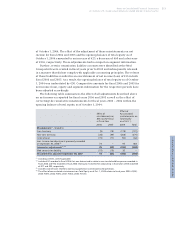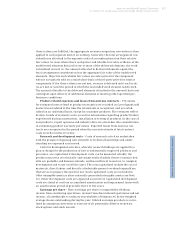Siemens 2007 Annual Report Download - page 223
Download and view the complete annual report
Please find page 223 of the 2007 Siemens annual report below. You can navigate through the pages in the report by either clicking on the pages listed below, or by using the keyword search tool below to find specific information within the annual report.-
 1
1 -
 2
2 -
 3
3 -
 4
4 -
 5
5 -
 6
6 -
 7
7 -
 8
8 -
 9
9 -
 10
10 -
 11
11 -
 12
12 -
 13
13 -
 14
14 -
 15
15 -
 16
16 -
 17
17 -
 18
18 -
 19
19 -
 20
20 -
 21
21 -
 22
22 -
 23
23 -
 24
24 -
 25
25 -
 26
26 -
 27
27 -
 28
28 -
 29
29 -
 30
30 -
 31
31 -
 32
32 -
 33
33 -
 34
34 -
 35
35 -
 36
36 -
 37
37 -
 38
38 -
 39
39 -
 40
40 -
 41
41 -
 42
42 -
 43
43 -
 44
44 -
 45
45 -
 46
46 -
 47
47 -
 48
48 -
 49
49 -
 50
50 -
 51
51 -
 52
52 -
 53
53 -
 54
54 -
 55
55 -
 56
56 -
 57
57 -
 58
58 -
 59
59 -
 60
60 -
 61
61 -
 62
62 -
 63
63 -
 64
64 -
 65
65 -
 66
66 -
 67
67 -
 68
68 -
 69
69 -
 70
70 -
 71
71 -
 72
72 -
 73
73 -
 74
74 -
 75
75 -
 76
76 -
 77
77 -
 78
78 -
 79
79 -
 80
80 -
 81
81 -
 82
82 -
 83
83 -
 84
84 -
 85
85 -
 86
86 -
 87
87 -
 88
88 -
 89
89 -
 90
90 -
 91
91 -
 92
92 -
 93
93 -
 94
94 -
 95
95 -
 96
96 -
 97
97 -
 98
98 -
 99
99 -
 100
100 -
 101
101 -
 102
102 -
 103
103 -
 104
104 -
 105
105 -
 106
106 -
 107
107 -
 108
108 -
 109
109 -
 110
110 -
 111
111 -
 112
112 -
 113
113 -
 114
114 -
 115
115 -
 116
116 -
 117
117 -
 118
118 -
 119
119 -
 120
120 -
 121
121 -
 122
122 -
 123
123 -
 124
124 -
 125
125 -
 126
126 -
 127
127 -
 128
128 -
 129
129 -
 130
130 -
 131
131 -
 132
132 -
 133
133 -
 134
134 -
 135
135 -
 136
136 -
 137
137 -
 138
138 -
 139
139 -
 140
140 -
 141
141 -
 142
142 -
 143
143 -
 144
144 -
 145
145 -
 146
146 -
 147
147 -
 148
148 -
 149
149 -
 150
150 -
 151
151 -
 152
152 -
 153
153 -
 154
154 -
 155
155 -
 156
156 -
 157
157 -
 158
158 -
 159
159 -
 160
160 -
 161
161 -
 162
162 -
 163
163 -
 164
164 -
 165
165 -
 166
166 -
 167
167 -
 168
168 -
 169
169 -
 170
170 -
 171
171 -
 172
172 -
 173
173 -
 174
174 -
 175
175 -
 176
176 -
 177
177 -
 178
178 -
 179
179 -
 180
180 -
 181
181 -
 182
182 -
 183
183 -
 184
184 -
 185
185 -
 186
186 -
 187
187 -
 188
188 -
 189
189 -
 190
190 -
 191
191 -
 192
192 -
 193
193 -
 194
194 -
 195
195 -
 196
196 -
 197
197 -
 198
198 -
 199
199 -
 200
200 -
 201
201 -
 202
202 -
 203
203 -
 204
204 -
 205
205 -
 206
206 -
 207
207 -
 208
208 -
 209
209 -
 210
210 -
 211
211 -
 212
212 -
 213
213 -
 214
214 -
 215
215 -
 216
216 -
 217
217 -
 218
218 -
 219
219 -
 220
220 -
 221
221 -
 222
222 -
 223
223 -
 224
224 -
 225
225 -
 226
226 -
 227
227 -
 228
228 -
 229
229 -
 230
230 -
 231
231 -
 232
232 -
 233
233 -
 234
234 -
 235
235 -
 236
236 -
 237
237 -
 238
238 -
 239
239 -
 240
240 -
 241
241 -
 242
242 -
 243
243 -
 244
244 -
 245
245 -
 246
246 -
 247
247 -
 248
248 -
 249
249 -
 250
250 -
 251
251 -
 252
252 -
 253
253 -
 254
254 -
 255
255 -
 256
256 -
 257
257 -
 258
258 -
 259
259 -
 260
260 -
 261
261 -
 262
262 -
 263
263 -
 264
264 -
 265
265 -
 266
266 -
 267
267 -
 268
268 -
 269
269 -
 270
270 -
 271
271 -
 272
272 -
 273
273 -
 274
274 -
 275
275 -
 276
276 -
 277
277 -
 278
278 -
 279
279 -
 280
280 -
 281
281 -
 282
282 -
 283
283 -
 284
284 -
 285
285 -
 286
286 -
 287
287 -
 288
288 -
 289
289 -
 290
290 -
 291
291 -
 292
292 -
 293
293 -
 294
294 -
 295
295 -
 296
296 -
 297
297 -
 298
298 -
 299
299 -
 300
300 -
 301
301 -
 302
302 -
 303
303 -
 304
304 -
 305
305 -
 306
306 -
 307
307 -
 308
308 -
 309
309 -
 310
310 -
 311
311 -
 312
312 -
 313
313 -
 314
314 -
 315
315 -
 316
316 -
 317
317 -
 318
318 -
 319
319 -
 320
320 -
 321
321 -
 322
322 -
 323
323 -
 324
324 -
 325
325 -
 326
326 -
 327
327 -
 328
328 -
 329
329 -
 330
330 -
 331
331 -
 332
332 -
 333
333 -
 334
334 -
 335
335 -
 336
336
 |
 |

Notes to Consolidated Financial Statements 223
(in millions of €, except where otherwise stated and per share amounts)
Notes to Consolidated Financial Statements
scope of IFRIC 12 are excluded from the scope of IFRIC 4 “Determining whether an
Arrangement Contains a Lease”. The Company plans to adopt IFRIC 12 beginning
October 1, 2008. The involvement of the Company in public-to-private service con-
cession arrangements is currently being evaluated.
In September 2007, the International Accounting Standards Board (IASB) issued
IAS 1, Presentation of Financial Statements (IAS 1). IAS 1 replaces IAS 1, Presentation
of Financial Statements (revised in 2003), as amended in 2005. The revision is
aimed at improving users’ ability to analyze and compare the information given in
fi nancial statements. IAS 1 sets overall requirements for the presentation of fi nan-
cial statements, guidelines for their structure and minimum requirements for
their content. The new standard is effective for fi scal periods beginning on or after
January 1, 2009, early adoption being permitted. The Company will determine the
expected effect of the revised IAS 1 and determine an adoption date.
3 Management estimates and judgments
Certain of these accounting policies require critical accounting estimates that
involve complex and subjective judgments and the use of assumptions, some of
which may be for matters that are inherently uncertain and susceptible to change.
Such critical accounting estimates could change from period to period and have a
material impact on fi nancial condition or results of operations. Critical accounting
estimates could also involve estimates where management reasonably could have
used a different estimate in the current accounting period. Management cautions
that future events often vary from forecasts and that estimates routinely require
adjustment.
Revenue recognition on construction contracts – The Company’s Groups, par-
ticularly PG, TS, I&S, PTD and SBT, conduct a signifi cant portion of their business
under construction contracts with customers. The Company generally accounts for
construction projects using the percentage-of-completion method, recognizing
revenue as performance on a contract progresses. This method places considerable
importance on accurate estimates of the extent of progress towards completion.
Depending on the methodology to determine contract progress, the signifi cant
estimates include total contract costs, remaining costs to completion, total con-
tract revenues, contract risks and other judgments. Management of the operating
Groups continually reviews all estimates involved in such construction contracts
and adjusts them as necessary. The Company also uses the percentage-of-comple-
tion method for projects fi nanced directly or indirectly by Siemens. In order to
qualify for such accounting, the credit quality of the customer must meet certain
minimum parameters as evidenced by the customer’s credit rating or by a credit
analysis performed by Siemens Financial Services (SFS), which performs such
reviews in support of the Company’s Corporate Executive Committee. At a mini-
mum, a customer’s credit rating must be single B from external rating agencies,
or an equivalent SFS-determined rating. In cases where the credit quality does not
meet such standards, the Company recognizes revenue for construction contracts
and fi nanced projects based on the lower of cash if irrevocably received, or con-
tract completion. The Company believes the credit factors used provide a reason-
able basis for assessing credit quality.
